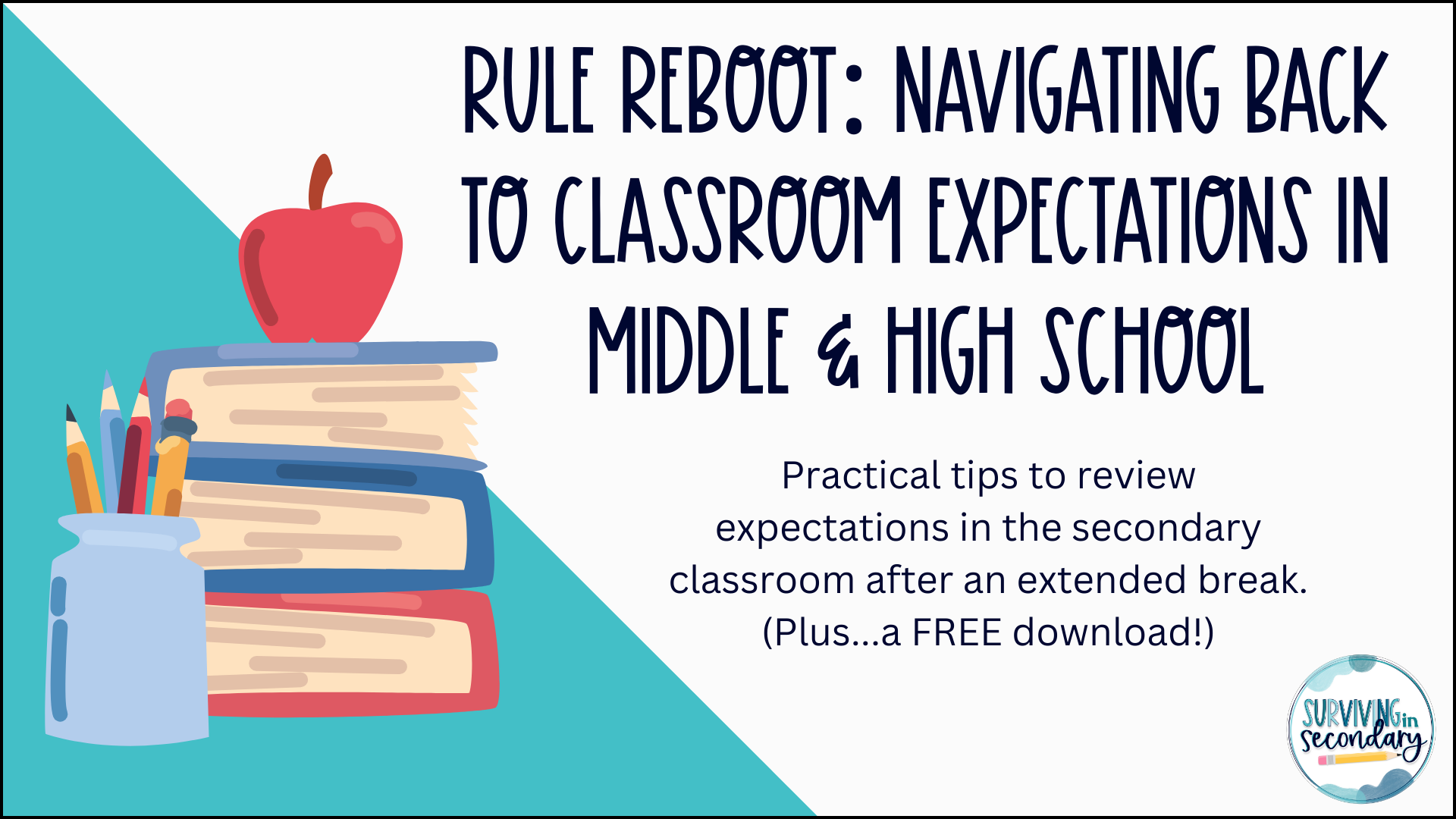Rule Reboot: Navigating Back to Classroom Expectations in Middle and High School

By Kasi @ Surviving in Secondary
Ready or not, here they come — back from the land of endless sleep-ins and infinite movie marathons, your students are re-entering your classroom after break! As we mentally prepare for their return, diving right into the cell cycle at 8:02 am on the first day back might not give you the results you are hoping for — especially if December was…well… let’s not dig up that chaos again.
Now is the time to dust off those classroom rules and expectations to reset your young scholars into learning mode. Here are some quick and easy student-oriented strategies to effectively reintroduce and reinforce expectations in the secondary classroom.
It’s About Recall
Even though our students are well-acquainted with our classroom expectations, the extended break might have (understandably!) shifted their focus away from our established norms. It’s not a case of forgetting entirely, but rather a need to refresh their memory. Just like recalling a familiar tune after a prolonged pause, a gentle reminder can reignite their familiarity with the guidelines. The break provided ample time for other interests to take the spotlight, but a brief review helps bring our collective expectations back into sharp focus.
It Can Be a Conversation
Engage in a structured conversation that re-establishes rapport and flows into reviewing classroom expectations. Create a safe space for students to express their concerns, share their experiences during the break, and discuss their needs for the rest of the school year. This dialogue not only helps in understanding their perspectives, but it also allows them to feel heard and valued. Use this conversation to set classroom goals for the new year! Whether it’s to show more kindness to others, clean up after themselves, or be in class on time, January is the classic time for goal setting, so take advantage! Not sure where to start? This classroom expectations discussion activity is the perfect guide to foster a positive conversation in your classroom.
Teach It with Activities
The last thing students want to do on the first day back is to listen to a 30-minute monologue on being respectful. Engage students in interactive activities that will engage them without stressing them out. Just like teaching academic content, behavior is a learned skill. Teach the behavior you expect to see the same way you would teach figurative language or solving two-step equations — with practice and review. How do you review behaviors like academics? Try an online gaming platform like Gimkit or Blooket, Have students complete this classroom expectation pixel art or cut and paste sort, and if you are really feeling brave, have students participate in role-playing activities to model appropriate behaviors (just the appropriate ones!)
Consistency is Key, but Flexibility is Necessary
Consistency in enforcing expectations is vital. Be fair and firm in upholding the established expectations and consequences. Consistency breeds predictability, fostering a sense of stability and security within the classroom. That being said, new moments arrive all the time and things you never thought you’d have to correct, you now have to correct. Never close yourself in a corner and never hide the changes being made from the students. If there is a new routine or expectation that has to be established, discuss it with them and give them a start date. New phone policy? Tell them on Thursday, remind them on Friday, and start it on Monday. Having issues with food in the classroom? Give them a three food strike rule. Whatever it might be, now is the time to not only maintain consistency, but update the boundaries needed to maintain a safe and productive learning environment.
Model Expectations and Provide Positive Reinforcement
As you continue throughout the next couple weeks, lead by example. Demonstrate the behavior and attitude you expect from your students. Whether it's punctuality, active participation, or respect for peers, research shows that modeling these behaviors can positively influence student conduct. Also, call out and praise students who are exhibiting the behaviors that you expect. Whether they follow the rules every day without any prompting or struggle to follow the same rule two days in a row, catch them displaying the appropriate behavior and specifically praise that choice they made that moment. Reinforcing that you noticed them doing the right thing will encourage them to keep doing the right thing!
Food for Thought
These are just a couple tried and true tips that don’t take up a lot of time, but can make a great impact on the classroom learning environment. But we know that our classroom isn’t your classroom, so feel free to tailor these tips and suggestions to your specific classroom dynamics and needs. Each classroom is unique, and adapting these strategies to fit your students' personalities and your teaching style can greatly enhance their effectiveness.
Here's to surviving & thriving this year!
Sign up below to join our email list and receive 4 FREE on-task posters for your classroom!
Thank you for subscribing!
Have a great day!
Copyright Jessica Amarant and KaSaundra Willis, 2024
